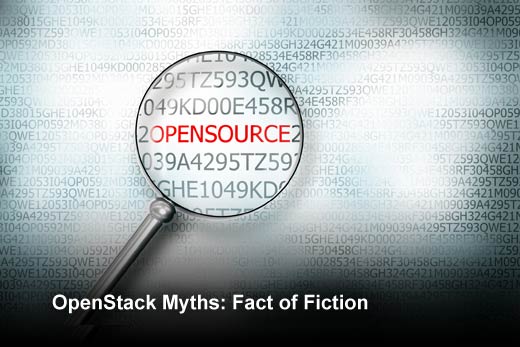Lured by the siren song of better business agility and accelerated innovation, an increasing number of companies are considering or have already deployed private clouds as part of their IT strategy. Since emerging in 2010 as an open-source initiative to help organizations build cloud services on industry-standard hardware, OpenStack has garnered much attention, but its adoption in production environments has been tempered by an assortment of perceived limitations, both real and imagined.
In this slideshow, ZeroStack has identified some of the most common preconceptions about OpenStack and explores whether they have a foundation of factual merit or can be debunked.
OpenStack Myths: Fact of Fiction
Click through for the truth about common OpenStack cloud deployment myths, as identified by ZeroStack.
Experts Required
Significant OpenStack expertise is required to build a private cloud.
True: There are more than 15 projects in OpenStack, with many more on the horizon to add functionality and address a broader set of use cases. Integration of these disparate components can be a daunting task that requires a substantial amount of subject-matter expertise and human resources – either developed in-house or sourced externally – to successfully execute. “Deploying the community edition of OpenStack is non-trivial,” notes Randy Bias, vice president of technology at EMC and an OpenStack Foundation Director. “Organizations who commit to that path are going to need anywhere from 10 to 30 people depending on skill level for a larger scale production cloud of say 10 to 20 racks.”
Unreliable
OpenStack isn’t reliable enough for the enterprise.
False: Many household names have made strategic investments in OpenStack projects to build pillars based on the technology at the core of their IT infrastructure. “OpenStack is now a mature cloud operating system,” declares Matt Haines, vice president of cloud engineering and operations for Time Warner Cable. “In the right hands, it can be used to build and support an enterprise-grade private cloud.” PayPal’s Vice President of Cloud and Platforms, Jigar Desai, adds, “PayPal has more than 1,500 applications on its site, and all need to work in harmony. Today we run all of our production front and mid-tier workloads on OpenStack.”
Not Designed for Smaller Environments
OpenStack is not friendly for smaller environments.
True: Ubuntu OpenStack requires at least seven machines (with one of them dedicated to managing the cluster) to start. Along with the significant startup cost and the time required to develop and/or source the necessary expertise, an OpenStack-based private cloud could be out of reach for smaller environments. “It’s important to keep in mind that EMC, Time Warner Cable, PayPal and WalMart have money to spare on new hires and retraining of staff as necessary to implement new technologies,” states John S. Webster of Network World. “They have the resources to smash barriers that smaller organizations or those with less IT capital might not have.”
Not Secure
OpenStack (and open source software in general) is not secure.
False: For many, the term “open source” often triggers doubts about the trustworthiness of the code. According to Bob Violino of CIO.com, these concerns are unfounded. “Open-source cloud computing products are designed from the outset with security in mind. For example, there are features such as identity management to monitor who has access to content, and data encryption to safeguard information while it’s at rest or in transit,” he declares. “Furthermore, open-source cloud software is peer-reviewed by community participants, leading to continuous improvements in the quality of security features and mechanisms. This community also monitors and rapidly discloses vulnerabilities and issues, and provides security updates to address them.”
Too Complex
The operational complexity of OpenStack is too high.
True: The initial deployment of OpenStack can be difficult but maintaining and upgrading the environment is often a greater challenge. The administrator must keep up with a regular cadence of new distributions, each with a bevy of new features to test, and incorporate them — with the least amount of disruption possible — into a dynamic platform supporting live services. In addition, with over 500 configuration options for OpenStack, and numerous customizations (e.g., Neutron plug-ins for networking, adding HA to Cinder volume instances, etc.) to make the environment production-worthy, operating an OpenStack-based private cloud can be tough to manage both technically and logistically.








